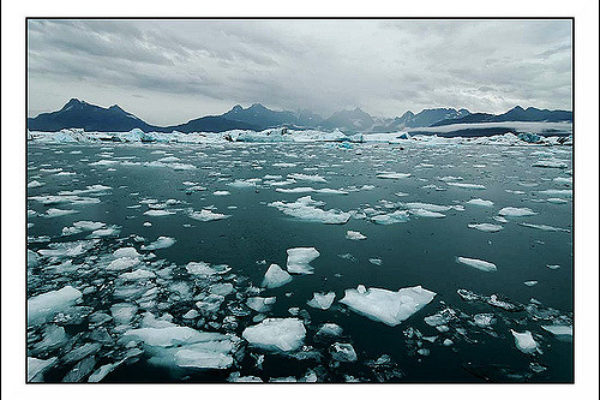Andrew Cassel’s Shattering Silos: Sharing Science on Social did what scientific discovery often does: blows your mind. With this presentation, he brought a passion for not just the subject, but for the benefits of sharing.
You could say that science is always exciting, but with the global conversation about climate change growing, it gives an opportunity to give more light to what scientists at his institution have been focused on for so long, especially in the Arctic.
Cassel’s first foray into sharing the exciting research and projects happening at University of Alaska Fairbanks didn’t go as planned. He approached a faculty member to ask questions, but discovered a communication challenge. There was a clash. Cassel, at first, felt he was a science communicator because he wanted to share—communicate—what researchers were doing with a wider audience. The word he used to describe the clash was arrogance—not necessarily in a bad way, but there needed to be more finessing in the messaging and how he tackled interviews with experts. He changed his mindset and instead of “science communicator” he adopted the notion of “science outreach.”
Maybe it’s a matter of semantics, but that small change made a huge difference in how others perceived what Cassel was doing and it made his subject matter experts more comfortable and willing to share. When you have a more willing participant, you’re more likely to get a subject to turn complex ideas into “the wow factor”—or, what the general audience will understand and get excited about.
Cassel introduced a series of “What you can do now” points—or WYCDNs. Say it with us: Wick-Din. It’s fun.
WYCDN #1: Spread Your Wings
Just go. Do it. Or do it better. Cassel had the chance to dive deep into science outreach when he attended Fulbright Arctic Week in Washington, D.C. His institution had several faculty members involved. He considered it a win that others at his university saw the value in Cassel being there to share, in real-time (and after), what was happening.
“If someone else pays their precious money for me to go do something for them – that’s an example of silos being shattered,” he said.
WYCDN #2: Share With Your Bosses
Cassel explained that, for the most part, our highest-up leaders aren’t likely following our main institutional accounts. They’re not seeing the day-to-day action on social media. So he suggests sharing data—and the context behind it—with decision-makers to gain buy-in. This also gives these leaders a chance to ask their burning questions, like, “What’s a hashtag?”
Cassel also brought up a point about academic researchers not caring about brand identity in the way we web professionals do—he uses looking at their conference posters as an example. They likely won’t contain your campus’ cool typography or color palette. Much of their loyalty is to their lab, their research, their funding agencies. Not that they aren’t also dedicated to their institutions, but they just don’t always have branding top of mind. This is where social media professionals can help—but also understanding where the scientists are coming from and what’s important to them builds stronger relationships.
One example he used is that “America’s Arctic University” is not an official tagline of UAF—but the faculty members love it and it makes their research standout and affiliation unique. (From an admissions standpoint, the real tagline, “naturally inspiring” may be more attractive and less cold-sounding, while still highlighting exciting education in a natural, wild state.)
WYCDN #3: Go to poster sessions.
Cassel explains that researchers are often introverts and escape into their work or labs. But when they’re standing by their poster, they’re “on”—they’re ready to talk, enthusiastically, about their work. He suggests that while they’re already in sharing mode, to pull them away from the table for a few minutes to capture them on video and ask three questions, in this order:
1) What’s your data about? (An ice breaker question.)
2) How is this helping the normal person?
3) Why are you doing this work HERE; why at this school?
The latter question can be golden admissions/marketing material, and it’s best to save that for last after they’ve been warmed up.
There was so, so much more about Cassel’s presentation than can fit into a brief and timely recap post, and we encourage you to check out the recorded presentation for the full scope and more WYCDNs and a look at the exciting, colorful content he’s created (including Alaska eye candy and Facebook “virtual” events that involve “going along” to volcanoes or aboard ships steering toward the Arctic.)
In closing, though, Cassel brought it back to science. He used an analogy that a glacier is made of single snowflakes, and it grows, gradually, into something bigger. He likened that to what we, as marketers, can do in the science world. As our world faces challenges that need innovative solutions, that need more research, by sharing in-progress studies and results, we’re helping change the world by helping to cut through some of the ignorance that lies out there.
“Scientists need your help,” he said. “Trust is a big thing; we can help that by sharing accurate science on social media. [It can be] a true symbol of awareness and truth that we desperately need.”
Editing to add: Congratulations to Andrew; this presentation won the Red Stapler award for his track.
Photo Credit: Flickr Creative Commons/Robert Voors


2 replies on “Shattering Silos: Sharing Science on Social (#tie7)”
Well done Andrew. Glad to see America’s Arctic University is still be used. You are doing great work and bringing social media to the leadership which is a big deal.
Great article about a great guy!